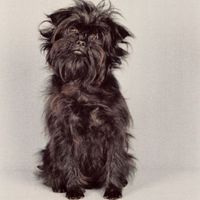
Neapolitan Mastiff / Mastino Napoletano, Italian Mastiff, Mastino, Neo

Breed history:
It is one of the oldest breeds in the world. It was Alexander the Great's favorite breed and it is a descendant of the war dogs - Mastiff type, which were used by the Romans and in the Middle East. Despite its age, this breed was recognized only after World War II. Specimens of this breed weere introduced into North America after 1970.
Description:
It is a large-sized, massive, vigorous, well-built dog, with a strong, brawny body. It has a big, square-shaped head and a flat and wrinkled forehead. The muzzle is short, broad with a black and big nose and thick lips that make the front of the mouth look like an inverted V. The head is covered with folds of skin hanging on the sides down to the middle of the neck. The eyes are deeply-set, with floppy, dark eyelids. The ears are medium-sized, pointed and drooping. The tail is medium-sized, wide at the bottom and tapered. The fur is very thin and has thick, short, rough, glossy hair. It can be blue-grey, grey, black, brown or reddish. The coat may have white patches on the chest and legs.
Personality:
It is an attentive, brave, intelligent, well-balanced, aggressive dog. It doesn't bark too much. It tolerates children and even loves them, if they don't tease it. It is protective, gentle with its master. It tends to dominate other dogs and other animals are accepted only if the dog was socialized with them from an early age.
Grooming:
The fur must be cleaned of the dead hair during the shedding period. The folds from the face should be frequently cleaned with a special solution to avoid them getting infected. Also, food leftovers can remain around the mouth, therefore it should be cleaned daily. They should not be exposed to the sun for a long time.
Living conditions:
It is a large dog, that is why it needs space to move. It can adapt to flat life, because it has a low level of activity, but its size should be taken into consideration. Its master should have experience in raising dogs.
Training:
This dog is not very difficult to train, but still the training should be done by a person with experience. Training needs to be gentle, well-balanced, consistent, done with patience. As long as they are pups, they shouldn't be allowed to do too much effort, to consume their energy at a fast rate. When mature, it won't feel like doing too much exercise.
Usefulness:
It is a good watchdog and also a good dog for protection.


Austrian Shorthaired Pinscher
Austrian Pinscher, Osterreichischer Kurzhaarpinscher, Österreichischer, Österreichischer Pinscher





